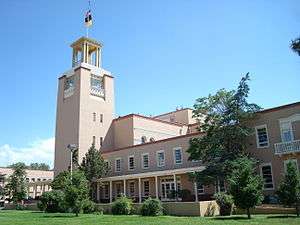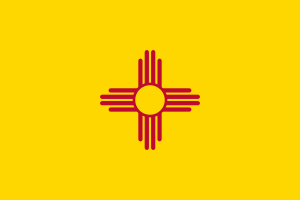New Mexico Department of Cultural Affairs

The New Mexico Department of Cultural Affairs is an executive branch agency of the New Mexico state government. Created in 1978 by the New Mexico Legislature, the department oversees the state museum, monument, arts, library, heritage preservation, and archaeology programs. Some 550 employees, spread throughout the state, are employed by the Department's fourteen divisions. The department's annual budget is approximately $35 million.
The Department of Cultural Affairs is currently directed by Cabinet Secretary Veronica Gonzales, who was nominated by Governor Susana Martinez on December 29, 2010.[1]
History
The information below is excerpted from the Department's official Web site.[2]
Seeds for the present-day Department of Cultural Affairs were sown during the 1977 Legislative session when the Executive Reorganization Act was passed, establishing the Educational Finance and Cultural Affairs Department (Laws 1977, Chapter 246).
The purpose of this newly formed department within the administration of Governor Jerry Apodaca was to bring the State's museums, historic monuments, library, arts and historic preservation programs under one collective umbrella. The legislation combined seven agencies and programs into a single department with a common responsibility for providing cultural and educational services to the citizens of New Mexico.
The structure of the Educational Finance and Cultural Affairs Department consisted of five divisions together with an administratively-attached agency. The five divisions included the Public School Finance Division, formerly a division of the Department of Finance and Administration; the Museum Division, formerly the Museum of New Mexico, an independent agency; the Library Division, formerly the State Library, an independent agency; the Arts Division, formerly an independent agency known as the Arts Commission; and a new creation, the Administrative Services Division.
The historic preservation program, formerly administered by the State Planning Office, was housed in the Administrative Services Division of the department in order to encourage consideration of historic preservation concerns in the planning process for all divisions of the department. Included as subdivisions of the Museum Division were the International Space Hall of Fame in Alamogordo and the Old Lincoln County Courthouse. The department employed approximately 270 people with a budget of some $5.5 million.
In 1979 -- Chapter 205, Laws of 1979 -- the Legislature authorized the merger of the Department of Finance and Administration (DFA) and the Educational Finance and Cultural Affairs Department upon the order of the Governor.
In 1980 the Office of Cultural Affairs (OCA) was created as its own agency, separated from Educational Finance, but administratively attached to the Department of Finance and Administration. The Laws of 1980, Chapter 55, defined the structure of OCA to include --- the Administrative Services Division, Museum (of New Mexico) Division, Natural History Museum Division, Arts Division, State Library Division, and International Space Hall of Fame Division (now the New Mexico Museum of Space History). The OCA was headed by the Cultural Affairs Officer, a position appointed by the governor and created to oversee all OCA divisions and operations. Until the spring of 1981, the officer had the dual responsibilities of serving as the administrator of the entire OCA and being the Museum Division director.
During April 2003, Governor Bill Richardson signed legislation elevating the Office of Cultural Affairs to Cabinet-level status. The name was subsequently changed to the Department of Cultural Affairs.
Divisions, museums, and historic sites
- Divisions[3]
- New Mexico Arts
- New Mexico Historic Preservation Division
- New Mexico Office of Archaeological Studies
- New Mexico State Library
- Cultural Centers
- Museums
- New Mexico Farm and Ranch Heritage Museum, Las Cruces.
- New Mexico History Museum, Santa Fe.
- Museum of Indian Arts and Culture, Santa Fe.
- Museum of International Folk Art, Santa Fe.
- New Mexico Museum of Art (formerly Museum of Fine Arts), Santa Fe.
- New Mexico Museum of Natural History and Science, Albuquerque.
- New Mexico Museum of Space History, Alamogordo.
- Palace of the Governors, Santa Fe.
- Historic Sites[4]
- Coronado Historic Site
- El Camino Real Historic Trail Site
- Fort Selden
- Fort Sumner (location of Bosque Redondo Memorial)
- Jemez Historic Site
- Lincoln Historic Site
Staff
As of 2016, staff are: Executive Staff:[5]
- Veronica Gonzales, Cabinet Secretary
- Greg Geisler, Administrative Services Division Director/ Chief Financial Officer
- Satya Neel, Chief Information Officer
- Loie Fecteau, New Mexico Arts Division Director
- Margie Marino, New Mexico Museum of Natural History & Science Director
- Mark Santiago, Farm & Ranch Heritage Museum Director
- Jeff Pappas, Historic Preservation Division Director
- Della Warrior, Indian Culture & Arts Museum Director
- Khristaan D. Villela, International Folk Art Museum Director
- Chris Orwoll, Space History Museum Director
- Michael Delello, Deputy Cabinet Secretary
- Rebecca L. Avitia, National Hispanic Cultural Center Director
- Andrew J. Wulf, New Mexico History Museum Director
- Mary Kershaw, New Mexico Museum of Art Director
- Jeff Pappas, New Mexico Historic Sites Division Director (Acting)
- Eric Blinman, Office of Archaeological Studies Director
- Kathleen Moeller-Pfeiffer, State Librarian
